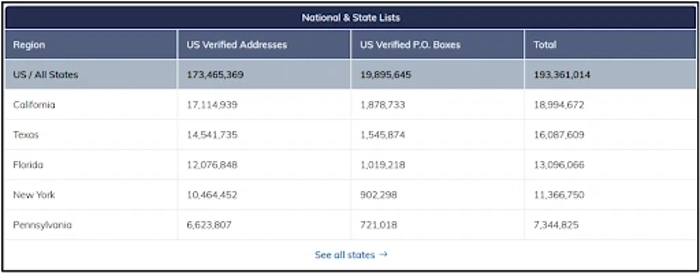Complete Guide to Address Data

Address data points are the components that make up an address, such as building number, predirectional, street name, postdirectional, ZIP Code, city, & state. Address data points can also refer to data associated with the address that isn't a part of the address itself, such as county information, FIPS Codes, lat/long coordinates, time zone, etc. When referenced individually, each component and data point is called address metadata.
The number of available metadata points associated with each address varies depending on the data source. Data points that are the basic address components are standard, but additional property data such as congressional district, vacancy indication, or other census data is not.
Smarty™ delivers address data points through our US Master Address List and address APIs. We provide up to 45 metadata points for over 193 million verified USPS and non-USPS addresses.
| US Address Master List | Us Address Validation API | US Address Autocomplete API |
|---|---|---|
In this article, we'll cover:
- What is address data?
- Address metadata
- How is address data collected
- What is address data used for?
- How to use address data management to improve data quality
What Is Address Data?
Elements of Address Data

Address data goes beyond just having a list of addresses in a database. Each address consists of components and associated data. Smarty categorizes these parts into four groups:
Root: This data involves the actual files themselves, such as the Input ID, Input Index, and Delivery Point Barcode.
Component: This is the standard data that you would consider for an address parsed into its components, such as the city, state, street name, and predirectional.
Metadata: Provides additional information about the address, such as address geocodes and whether the address is commercial or residential.
Analysis: These data points inform you about how the data was obtained, the validity of the data, and other similar contexts.
Address Metadata
Address metadata goes beyond the components of an address. For every address, Smarty can provide up to 45 metadata points. These include:
Root |
Components |
Metadata |
Analysis |
|---|---|---|---|
| Input Index Candidate Index Delivery point barcode Delivery line 1 Delivery line 2 Last line Addressee |
Primary number Street name Street predirectional Street postdirectional Street suffix Secondary number Secondary designator Delivery point check digit City State ZIP Code ZIP+4 Code Delivery point PMB designator PMB number Urbanization |
County FIPS County name County route RDI Latitude Longitude Building default indicator Congressional district UTC offset Observes DST Precision Time zone |
CMRA EWS Match DPV™ match code DPT™ footnotes Active Vacant Footnotes LACSlink code LACSlink indicator |
How Is Address Data Collected?
Web Forms, Opt-Ins, and Signups

The most common way companies collect customer addresses is through web forms. These forms are easy to use and can automatically collect address data from new customers.
Companies simply include a web form for each new customer with a required address field. The address field is occasionally optional, so customers can choose if they want to provide their physical location.
Since typos and errors are common, address data collected from customer forms should be standardized and validated at entry by integrating an address autocomplete API into customer and employee-facing forms or shortly after the address enters the system.
Purchasing a Dataset of Address Data
Companies may need more than just their customers' addresses for things like business growth analysis, brand awareness, and location planning. If you need to expand your address data, you can purchase one from an address data provider.
For example, Smarty's US Master Address List has over 193 million US addresses that are updated monthly to ensure they are valid. This list can be customized to fit specific needs; lists can be restricted to only include addresses in specific states, and the amount of metadata can be limited, so you only pay for the data you need.

What Is Address Data Used For?
Shipping
The instantly recognizable use for address data is to send mail and packages to people or businesses. This helps ensure that the packages or mail sent to customers is delivered accurately, as well as decreasing the potential cost of returned or damaged mail.
Verifying User Identity
People can easily create new email addresses, so a customer's physical location is a more reliable way to verify their identity. There are some cases where a geographical location has multiple valid addresses, but an address verification tool can automatically check for duplicate addresses in your address database.
Geocoding for Spatial Analysis

Geocoding takes street address information and provides approximate longitude and latitude coordinates of those addresses so that the locations can be plotted on a map. These coordinates can also be used for spatial analysis.
Spatial analysis compares locational data with other types of data to find patterns, opportunities, and risks based on specific locations. This type of analysis is commonly used to predict the weather, manage traffic, check the progression of diseases, and plan cities.
There are many different ways to use spatial analysis in a business setting. Some of the more common uses of spatial data are:
- Predicting customer shopping habits
- Planning delivery schedules
- Deploying region-specific marketing campaigns
- Marketing and Geotargeting
Geotargeting uses spatial analysis to tailor advertisements and marketing campaigns for people in specific locations. It allows businesses to only spend advertising money where their product or service is relevant; there's little point in advertising a product or service in Wisconsin if it's only available for residents of Colorado.
Lead Generation
If your address lists only include your existing customers, you will only be able to expand your postal mail reach as customers purchase your products or services. However, an address database would allow you to target potential customers based on their geographic location.
Using Address Data Management to Improve Data Quality
Address Standardization and Validation
Address data management is the process used to store, manage, and maintain address lists. Address standardization and validation are address data management practices that ensure your address database contains accurate addresses. Address standardization involves formatting address data to match the country's address formatting standards. Doing so makes your address data easier to read and, therefore, easier for the post office to deliver.
Address validation takes address data management to the next level. To validate an address, a standardized address is compared to a national address database to see if the address is accurate and deliverable.
Address Standardization and Validation Tools
Instead of manually checking every address against a national address database, an address standardization tool can standardize and validate address lists automatically. The best tools are CASS-Certified, a certificate the USPS awards to address validation solutions that meet their quality standards.
Not everyone needs the highest-powered tool to get the job done; sometimes, the simple, less expensive tools will do the trick. When deciding the right tool for you, consider the following:
- Do you need single-address validation, or do you need to validate an address database?
- Do you need international address validation? (outside of the US)
- What address data do you want to analyze?
- Does the tool's terms of use allow you to save and analyze the data?
- How will a new address validation tool fit into your current systems and workflow?
The Costs of Bad Address Data

There are many costs and risks associated with shipping something to the wrong address. Here are just a few to remember:
Expensive Mistakes: Shipping to the wrong address costs time, labor, and money. The USPS may even charge you a fee to change the address or to return the undeliverable package.
Company Reputation: Your reputation will be harmed if your customers expect mail that never comes. Bad address data also slows down mail delivery, further frustrating your customers.
Scam Risks: Sending postal mail to an incorrect address, especially confidential mail, opens you and your customers to scammers. Scammers can also use poor address data management to receive multiple free trials or merchandise.
By using Smarty's Master Address List and address APIs, you can rest easy knowing that every address has been validated and has the right metadata for your needs. That means fewer unhappy customers, more financial savings, and plenty of data for business analysis. Start a free trial today.